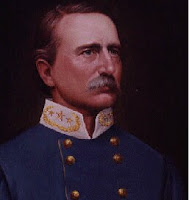Joseph B. Kershaw, son of John Kershaw and Harriet DuBose, was born on 5 January 1822 in Camden, South Carolina, the site of the famous Revolutionary War battlefield where the first subject of this article, Mordecai Gist, made his fame (See:
Mordacai Gist - The Rock at Camden). This, combined with the fact that he came from a military lineage, most certainly influenced Kershaw’s decisions concerning a vocation in the military.
Both of the families of Kershaws and Duboses were represented by more than one member, either in the Continentals or the State troops, during the War of the Revolution, Joseph Kershaw, the most prominent of them, and the grand father of the subject of this sketch, having lost his fortune in his efforts to maintain the patriot cause.
No analysis of the Battle of Gettysburg in July 1863 is complete without an inclusion of the activities of Kershaw’s Brigade on the second day of that great battle. Although Confederate General Joseph B. Kershaw saw action before and after July 1863, he is largely remembered for his pivotal role in the fighting on 2 July 1863.
Kershaw was a lawyer in civilian life and had military service prior to the War Between the States as a Lieutenant in the Palmetto Regiment, which saw service in the Mexican War. He was a member of the South Carolina State Legislature and an active participant in the Secession Convention which led to South Carolina’s dissolution of the Union. He immediately raised a regiment, soon to be known as the 2nd South Carolina Regiment, which saw service early in the war during the bombardment of Fort Sumter and at the Battle of First Manassas, or First Bull Run, on 21 July 1861.
Several battles later, and as a Brigadier General, Kershaw found himself in command of a brigade of South Carolinians in Major General Lafayette McLaw’s division at the Battle of Gettysburg in early July 1863. His brigade was involved in the awful fighting in and around the now famous Wheat Field, Peach Orchard, and Rose Farm on 2 July 1863. Kershaw’s experiences at Gettysburg are forever visible to researchers and the curious since he provided some of the greatest details of the campaign of any of the Confederate commanders in his reports. Kershaw reports,
In a few minutes after my line halted, the enemy advanced across the wheat-field in two lines of battle, with a very small interval between the lines, in such a manner as to take the Seventh South Carolina in flank. I changed the direction of the right wing of the regiment, under Lieutenant-Colonel [Elbert] Bland, to meet the attack, and hurried back to General Semmes, then some 150 yards in my right rear, to bring him up to meet the attack on my right, and also to bring forward my right regiment (Fifteenth South Carolina, Colonel De Saussure), which, separated from the command by the artillery at the time of the advance, was now cut off by Semmes' brigade. Its gallant and accomplished commander had just fallen when I reached it, and it was under the command of Major [William M.] Gist. General Semmes promptly responded to my call, and put his brigade in motion toward the right, preparatory to moving to the front. I hastened back to the Seventh Regiment, and reached it just as the enemy, having arrived at a point about 200 yards from us, poured in a volley and advanced to the charge. The Seventh received him handsomely, and long kept him in check in their front. One regiment of Semmes' brigade came at a double-quick as far as the ravine in our rear, and for a time checked him in their front. There was still an interval of 100 yards between this regiment and the right of the Seventh, and into this the enemy was forcing his way, causing the Seventh to swing back more and more, still fighting at a distance not exceeding 30 paces, until the two wings were doubled on each other, or nearly so.
The observant reader will notice the names of relatives of Generals Gist and Desaussure in Kershaw’s report. Kershaw was not always the producer of detailed battle reports, however, and he incurred the wrath of General Pierre Gustave Toutant Beauregard early on in the war. Author Larry Tagg wrote,
-- Kershaw irritated commanding general Brig. Gen. P.G.T. Beauregard by writing a self-promoting article for a South Carolina newspaper. Beauregard later referred to him as “that militia idiot.” After Beauregard was transferred away from the Virginia army, Kershaw took command of a brigade in January 1862 when its previous commander, Brig. Gen. Milledge Bonham, resigned in a huff over a seniority dispute. Two weeks later Kershaw was promoted to brigadier general.
It seems that Kershaw learned his lesson well. Kershaw would go on to command a division and achieve the rank of Major General before being captured at Saylor’s Creek, Virginia, three days before General Robert E. Lee surrendered at Appomattox Court House. Kershaw is undoubtedly one of the few Confederate Generals to see the beginning and the end of the War Between the States.
Kershaw was a Master Mason in what is now known as Kershaw Lodge No. 29, Grand Lodge of Ancient Free Masons of South Carolina, and served as the Grand Master of Masons in South Carolina in 1873 - 1874. After the War; Kershaw returned to the legal profession, became a Circuit Judge, was a member of the South Carolina State Senate, and was the Postmaster in his native town of Camden. He died on 13 April 1894.



